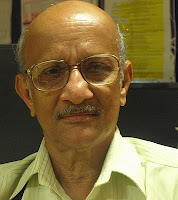Panjim, the capital of Goa, has very few rivals as far as beauty and architecture in the whole of India. Its wide roads with huge shady trees lining them and the many Indo-Portuguese houses give one a feeling of great joy. I particularly like to take a walk from the Kala Academy area to the ‘ferry’ bus stop whenever I happen to be in Panjim. The cool and salty breeze of the Mandovi acts as a balm on frayed and irritated nerves. This is a city that we all love and cherish.
This city has changed a lot during the last 10 years. So what do we do if we want to know how Panjim looked like when it was established and how it has grown and evolved ever since? Vasco Pinho’s Snapshots of Indo-Portuguese History – I: Panjim would be a great beginning.
 |
| Frederick Noronha |
Vasco Pinho’s book is a collection of events and monuments associated with Panjim. Along with Panjim he also explores the areas that surround this city: Dona Paula, St. Inez and Taleigao. This book is not arranged in a chronological sequence because the aim of the author is only to present the main “vignettes” and important events in the life of Panjim. The topics dealt in the book are described briefly and they surely appeal the reader. Vasco Pinho was compelled to write this book because, “…the entire stretch of Indo-Portuguese history has been converted into an object of relentless attack whenever and wherever it suits some of us. As a result, the level of ignorance about this period is not just palpable, it is incredible.”
Earlier I had made a reference to the cool and salty breeze of the Mandovi. The etymology of this word “Mandovi” had always bothered me as I came to know that many places outside of Goa were also called Manddvi. But not anymore. Pinho explains, “The name Mandovi or Manddvi is thus derived from the office where duties were collected or from the local practice of collecting mandd (duties) on goods during the pre-Portuguese Hindu and Muslim periods.” A custom-post in Persian or Farsi is known as Mandubi, and that explains, I guess, why many places in India have a name closely similar to Mandovi.
A very tragic incident which occurred in the Mandovi is also narrated. “For the people of Goa, the Twentieth Century began on a tragic note. A major disaster occurred on December 3, 1901, at 7:00 a.m. The motorized launch ‘GOA’ capsized while crossing the Mandovi from Verém to Pangim. Of the estimated 165 passengers travelling by that launch, 81 met with their watery grave. The passengers were on their way to Velha Goa’s Feast.” Vasco Pinho further informs us that, “On December 3, 1902, a cross was erected on the southern bank of the Mandovi, near the Caes dos Gujires, in memory of the 81 persons who had perished in that disaster.”
This book is not written in a style that can be termed academic. It was also not intended to be so in the first place. But the information contained in the pages of this book could come in handy to a scholar researching about Panjim. There is also another reason: all the inscriptions on various monuments in Panjim are translated in English. One need not run from pillar to post to read the Portuguese writings, especially because not many Goans can boast of proficiency in the Portuguese language.
Most of the book is a collection of facts (or should I say glimpses?) strung one after the other, which while making the narrative rather stilted, could be used to study how the city grew in time and space. Vasco Pinho could have arranged the various events, monuments and buildings in his book in such a way that it would give a picture or a sense of the development and evolution of Panjim. Many photographs which this book contains are not large enough and one has to tax one’s eyes to search for the details.
In this snapshot history of Panjim, the human angle or the people feature rather rarely. It is a history of this building, that street or some other monument or landmark. I recall Shakespeare once remarking, “What is a city without its people?”
On the other hand, it is worthwhile to know what how a particular street or building was known in the past. This is because in the recent years, Panjim has been at the receiving end of cultural fundamentalism and chauvinism. Efforts are being made to erase names and things that “sound” or “look” Portuguese. Against this background of dark foreboding, Vasco Pinho’s writing would serve to preserve the memory – or rather the history – of this city we love so much. Vasco Pinho also tells us that after liberation Panjim became Panaji, which is a Marathicized version of the Konknni Ponnje.
A list of all the Viceroys and Governors of Portuguese India is also given in the annexure.
Lastly, a word of praise must be made to this ‘self-published enterprise’ of Vasco Pinho. The first edition came out in 2007 and due to the overwhelming response, the author set out to revise and enlarge the book in the second edition published in 2009. As much as it is difficult to write a book in the first place, publishing a book using money from one’s own pocket and marketing it can be a huge headache. So kudos to the daring and enterprise of Vasco Pinho!
Snapshots of Indo-Portuguese History – I: Pangim (2nd Ed.) by Vasco Pinho (Panaji: Self published), 2009; pp. 141, Rs. 295/-
Email: vpinho@sancharnet.in
(A version of this article appeared on Gomantak Times, dt: September 20, 2011)

It has been brought to my notice that the e-mail address of the author mentioned above is not functional.
ReplyDelete